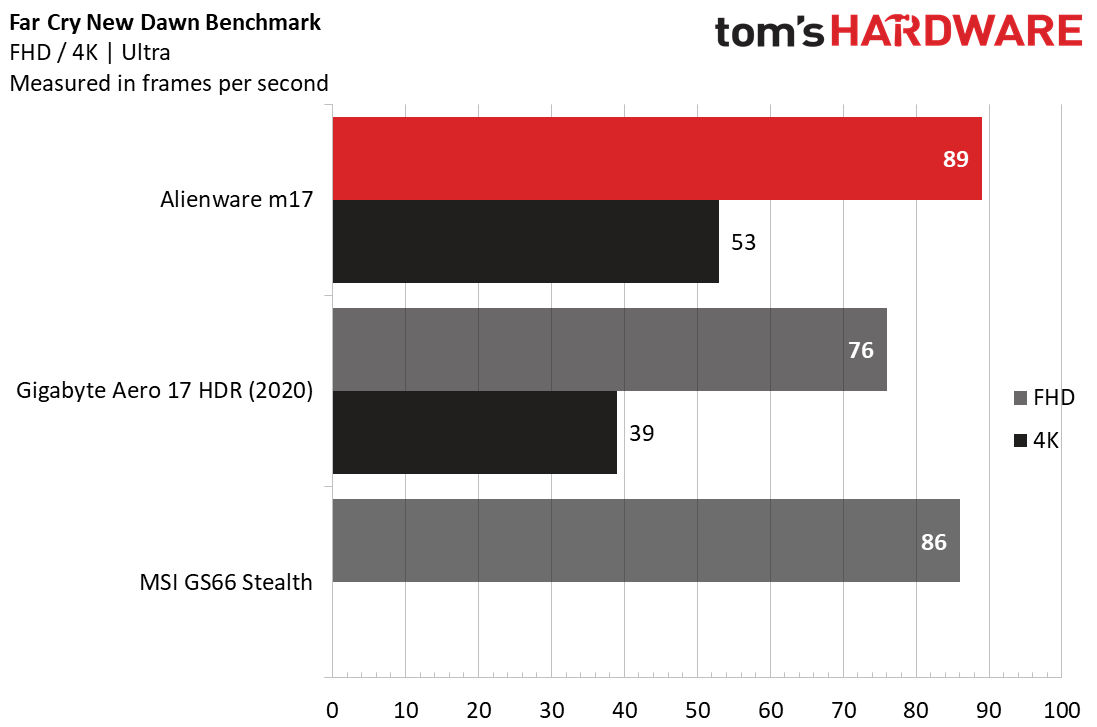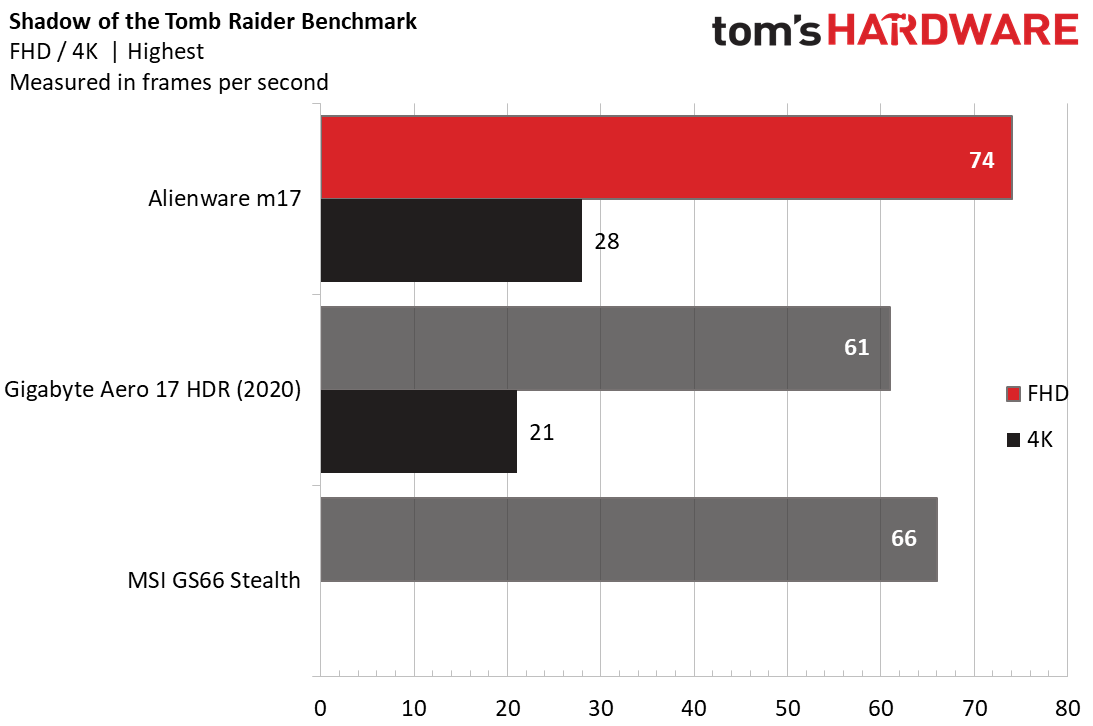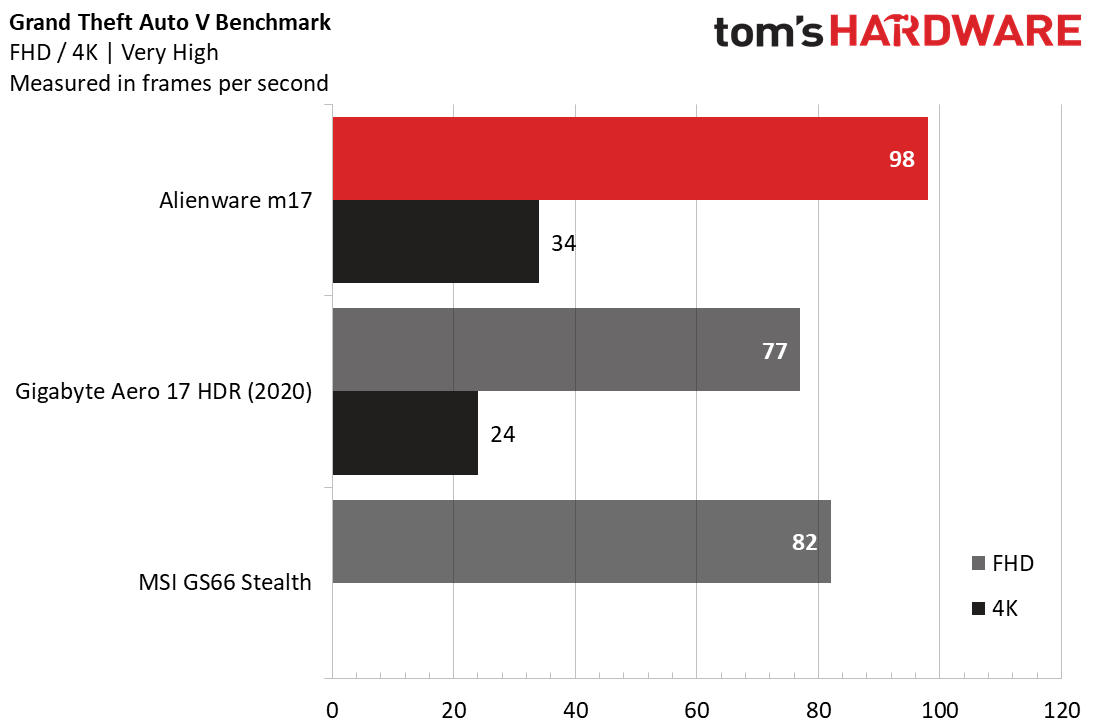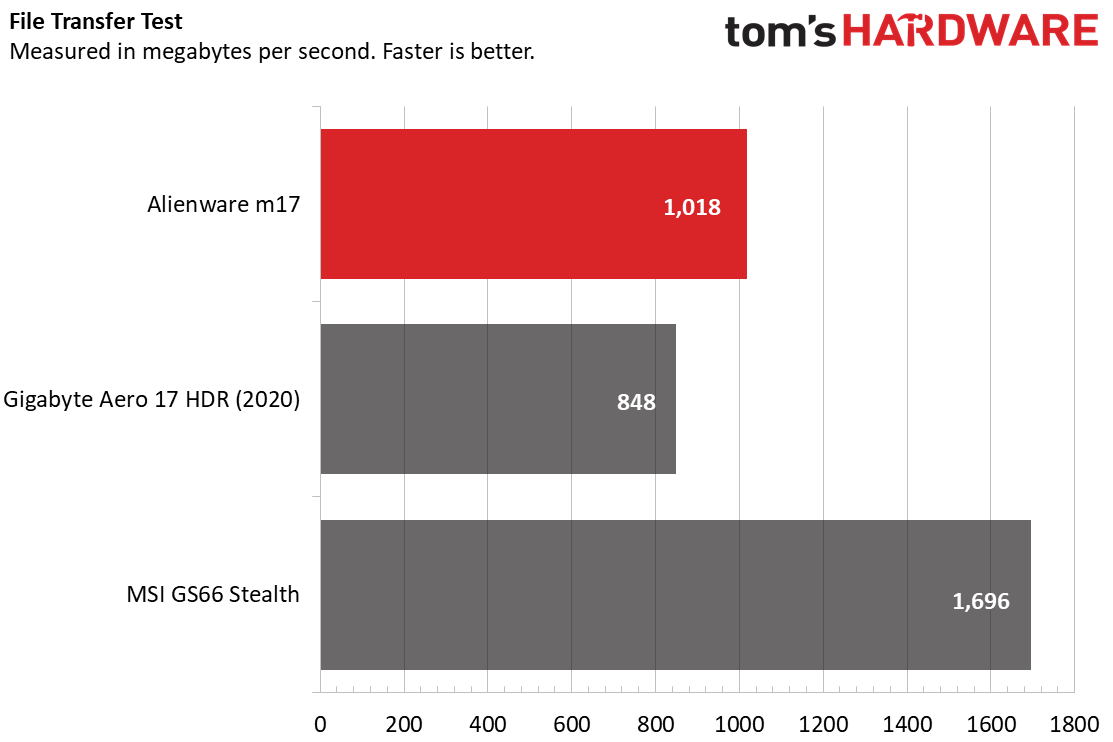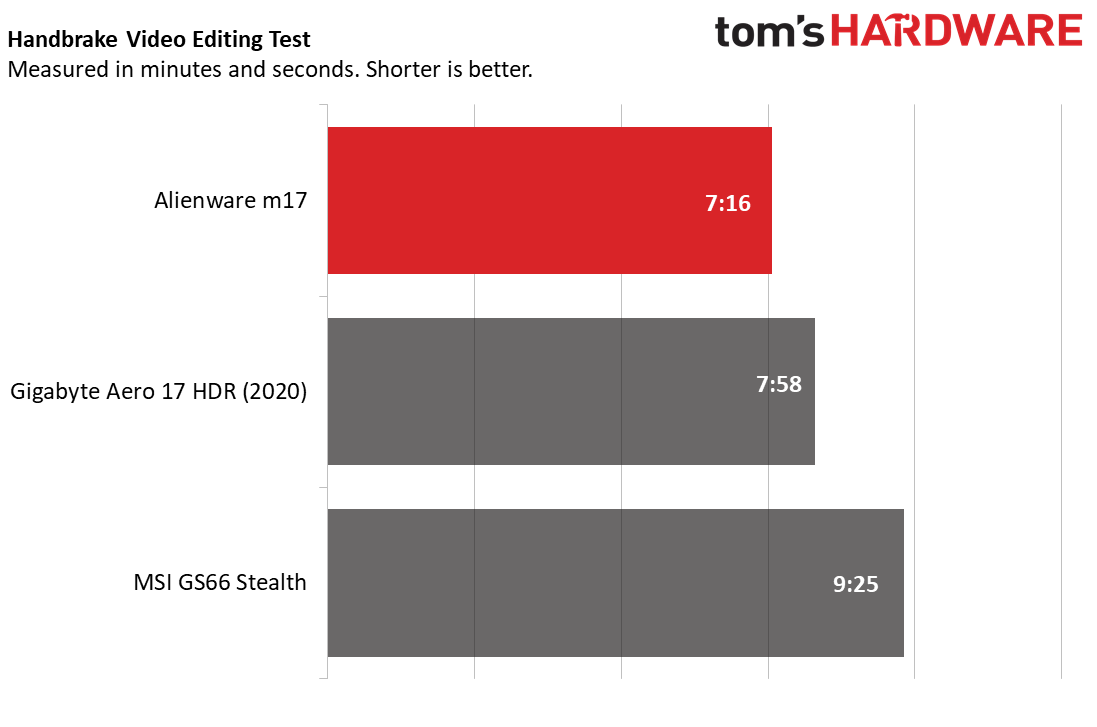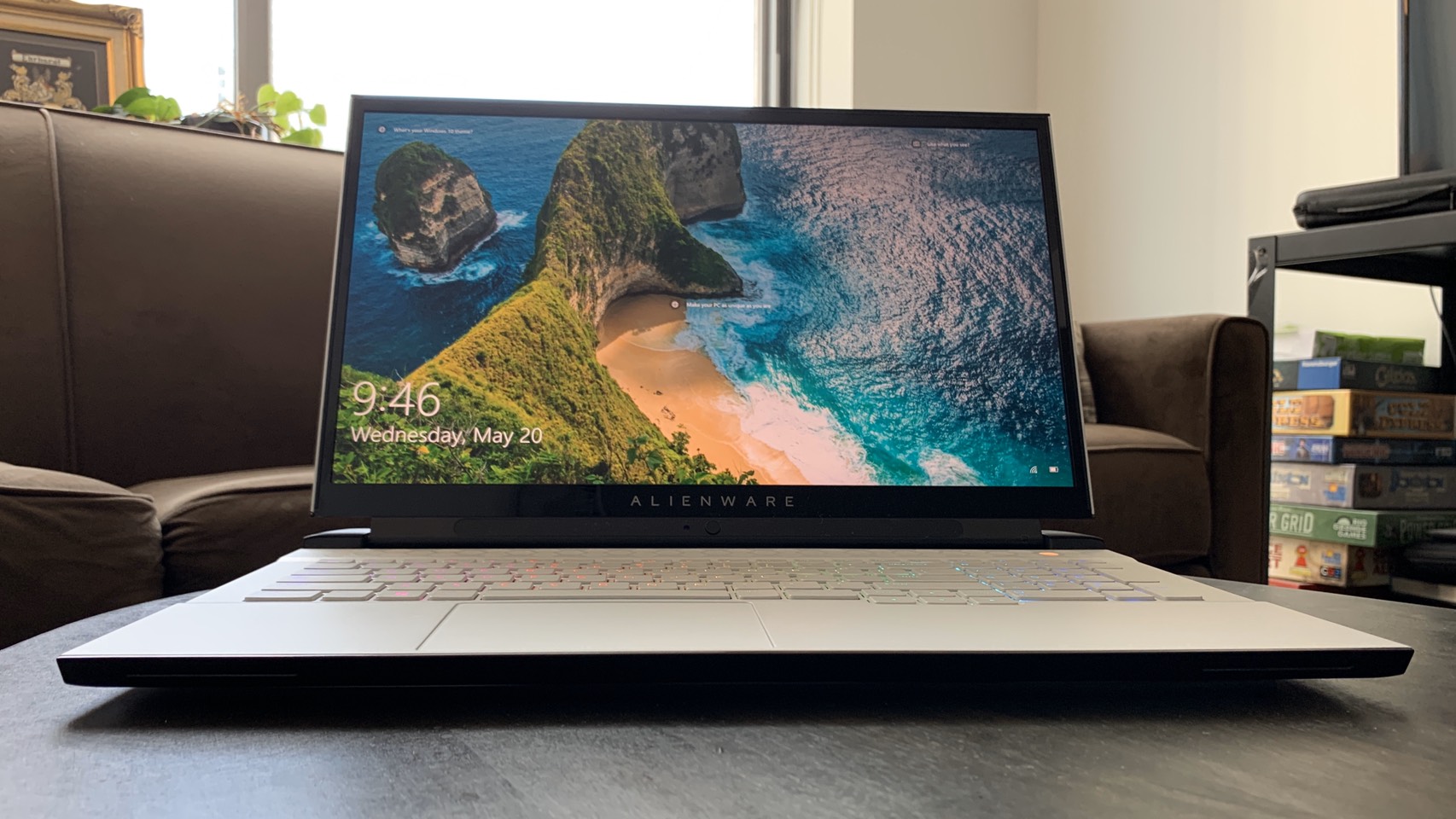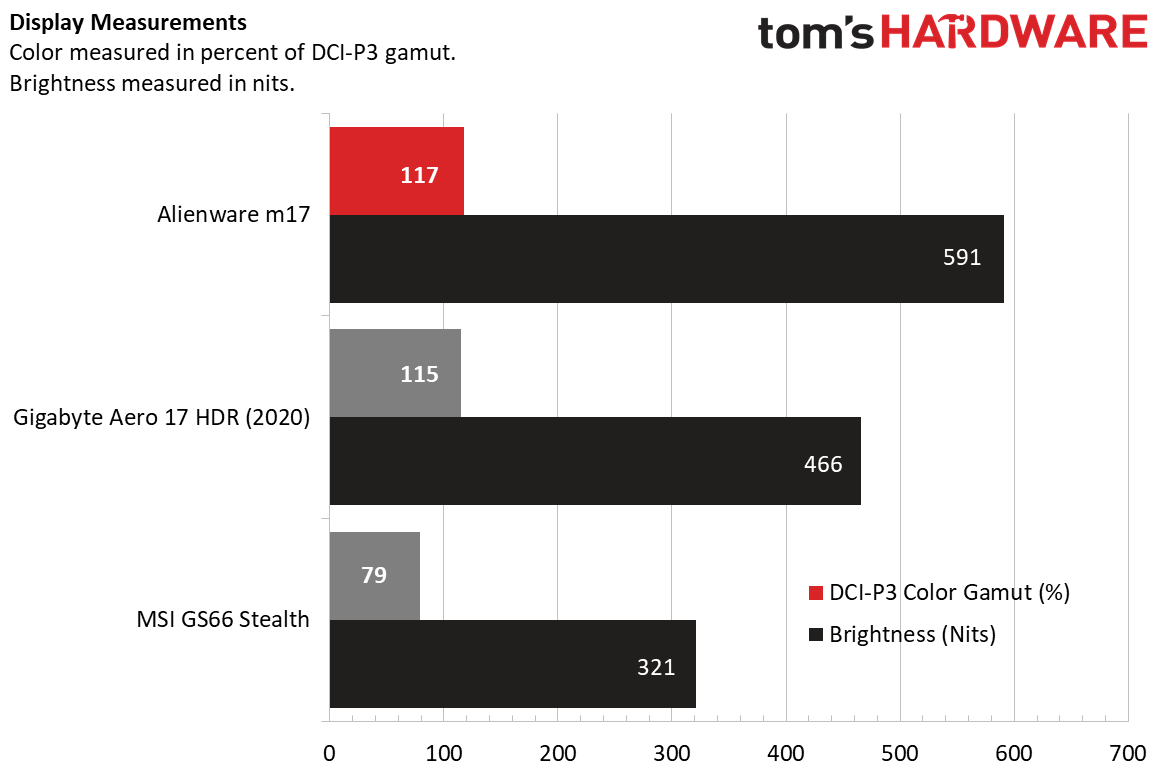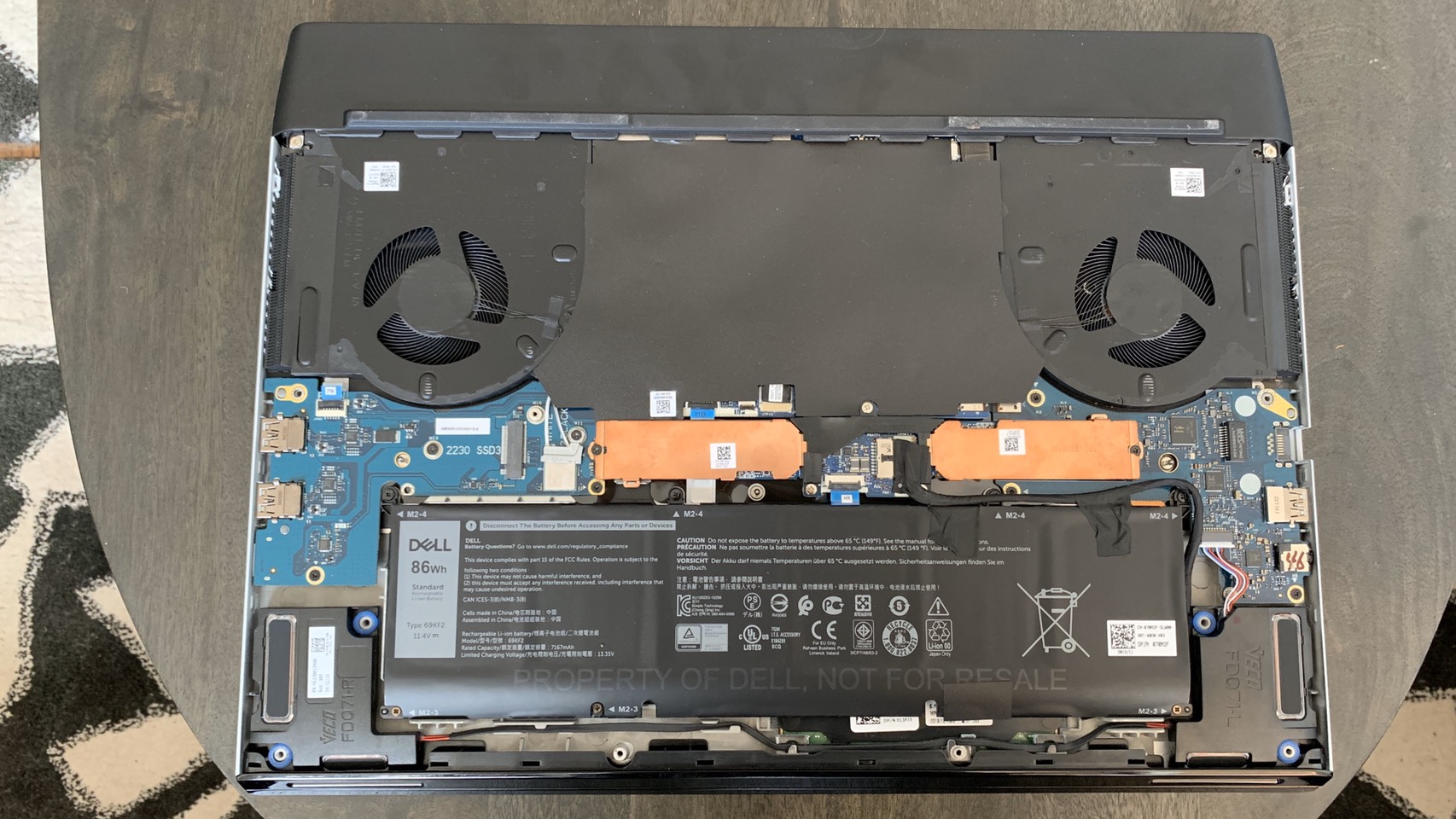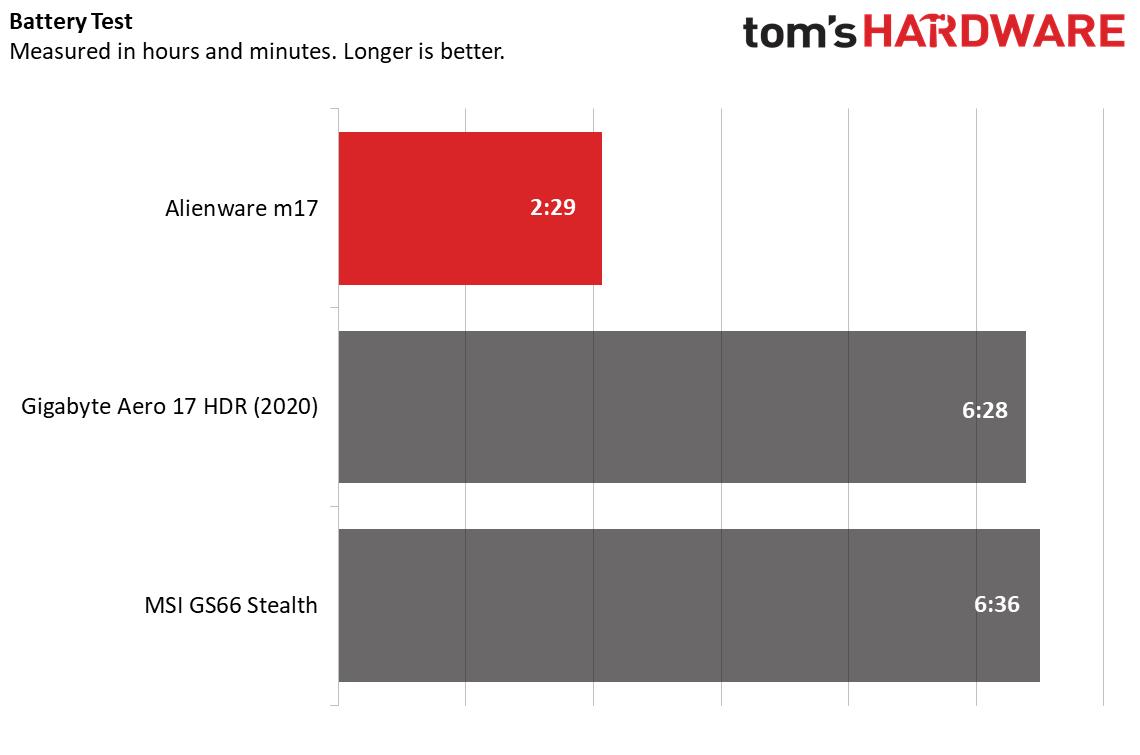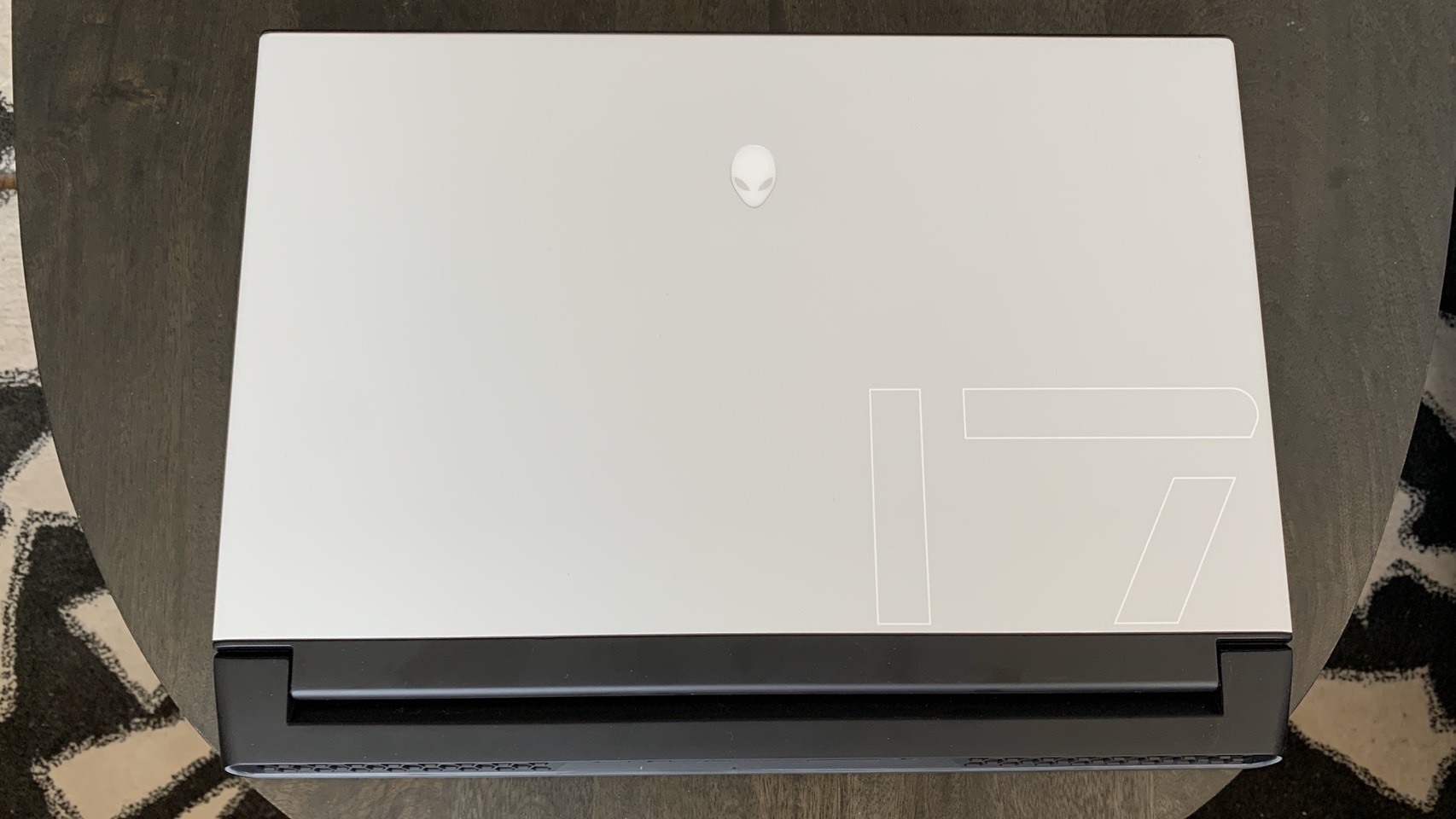Tom's Hardware Verdict
The Alienware m17 R3 is about as powerful as a gaming laptop can get while keeping under 1 inch of thickness, and has a great screen and striking design.
Pros
- +
Bright, colorful, large screen
- +
Comfortable, clicky per-key RGB keyboard
- +
Thin for a gaming laptop
Cons
- -
Hot and loud
- -
Poor battery life
- -
Pricey
Why you can trust Tom's Hardware
Alienware’s m17 R3 gaming laptop ($1,549.99 to start, $3,529.99 as tested) will cost you as much as some cars, which makes sense for how fast it can run. It’s able to keep up with the best gaming laptops out there thanks to its optional 10th Gen Intel Core i9 10980HK CPU and Nvidia Geforce RTX 2080 Super GPU, both of which sit at the top of their respective product stacks.
When it comes time to game, this Alien-themed laptop delivers stellar performance and beautiful images in an attractive chassis with a very-snappy keyboard. As you might expect from a 17-inch laptop with high-end components, the laptop gets weak battery life, has fans that run loud under load and gets minimal battery life.
However, if you can afford to pay the premium, the Alienware m17 R3 will elevate your gaming experience even more than a UFO tractor-beaming up cattle.
Alienware m17 R3 Specifications
| CPU | Intel Core i9-10980HK |
|---|---|
| Graphics | Nvidia Geforce RTX 2080 Super |
| Memory | 32GB DDR4 |
| Storage | 2x 1TB PCIe M.2 SSD (connected over RAID0) |
| Display | 17.3 inch 3840 x 2160 60Hz HDR400 |
| Networking | 802.11ax Wi-Fi, Bluetooth 5.0 |
| Ports | 1x Thunderbolt 3, 3x USB Type-A, 1x Alienware Graphics Amplifier, 1x RJ-45 Ethernet, 1x microSD card reader, 1x HDMI 2.0b, 1x Mini DisplayPort, 1x 3.5mm headphone/mic jack, |
| Camera | 720p webcam |
| Battery | 86 Whr |
| Power Adapter | 330W |
| Operating System | Windows 10 Pro |
| Dimensions(WxDxH) | 15.7 x 11.6 x 0.9 inches |
| Weight | 6.6 pounds |
| Price (as configured) | $3,529.99 |
Design of Alienware m17 R3
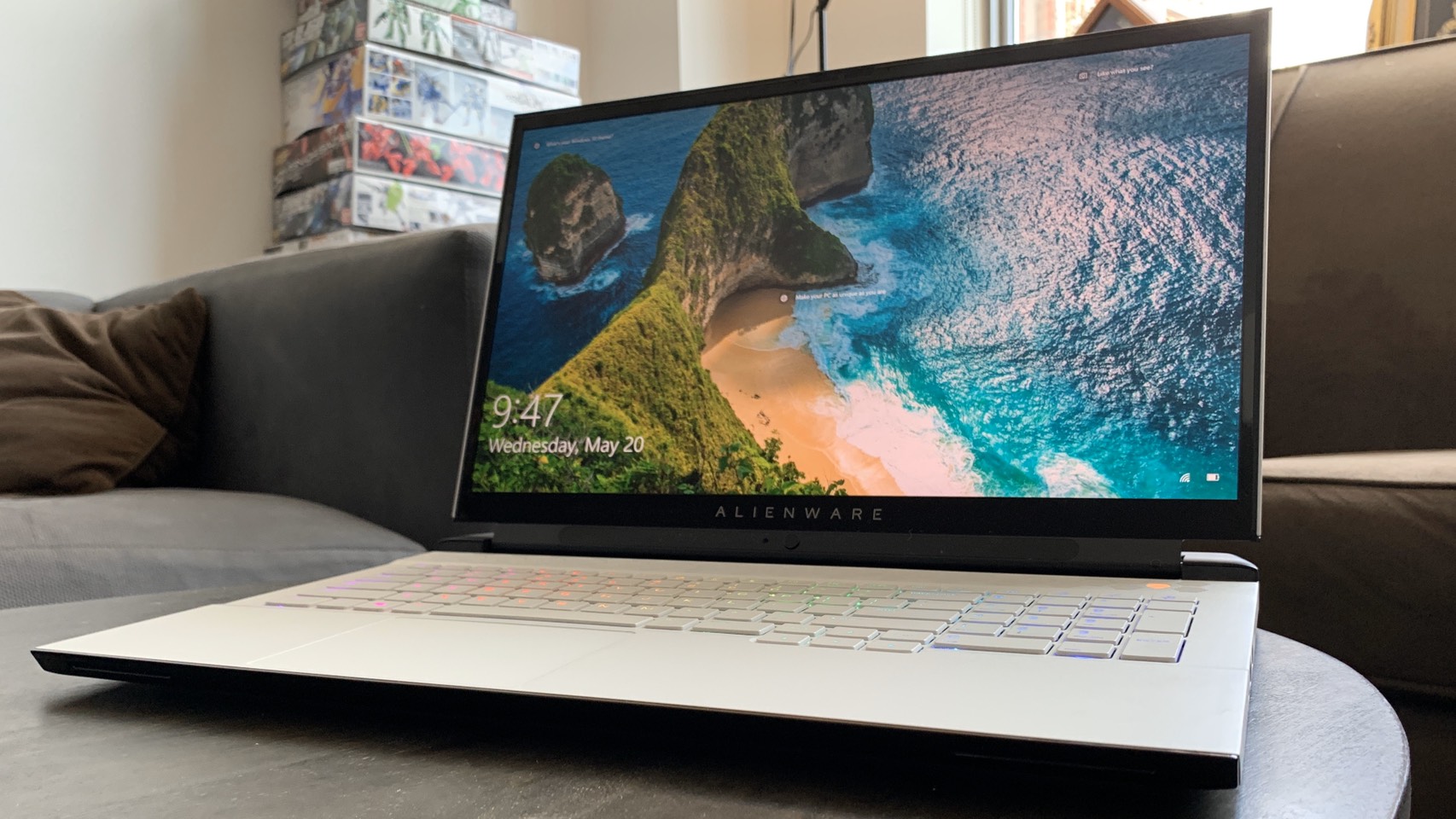


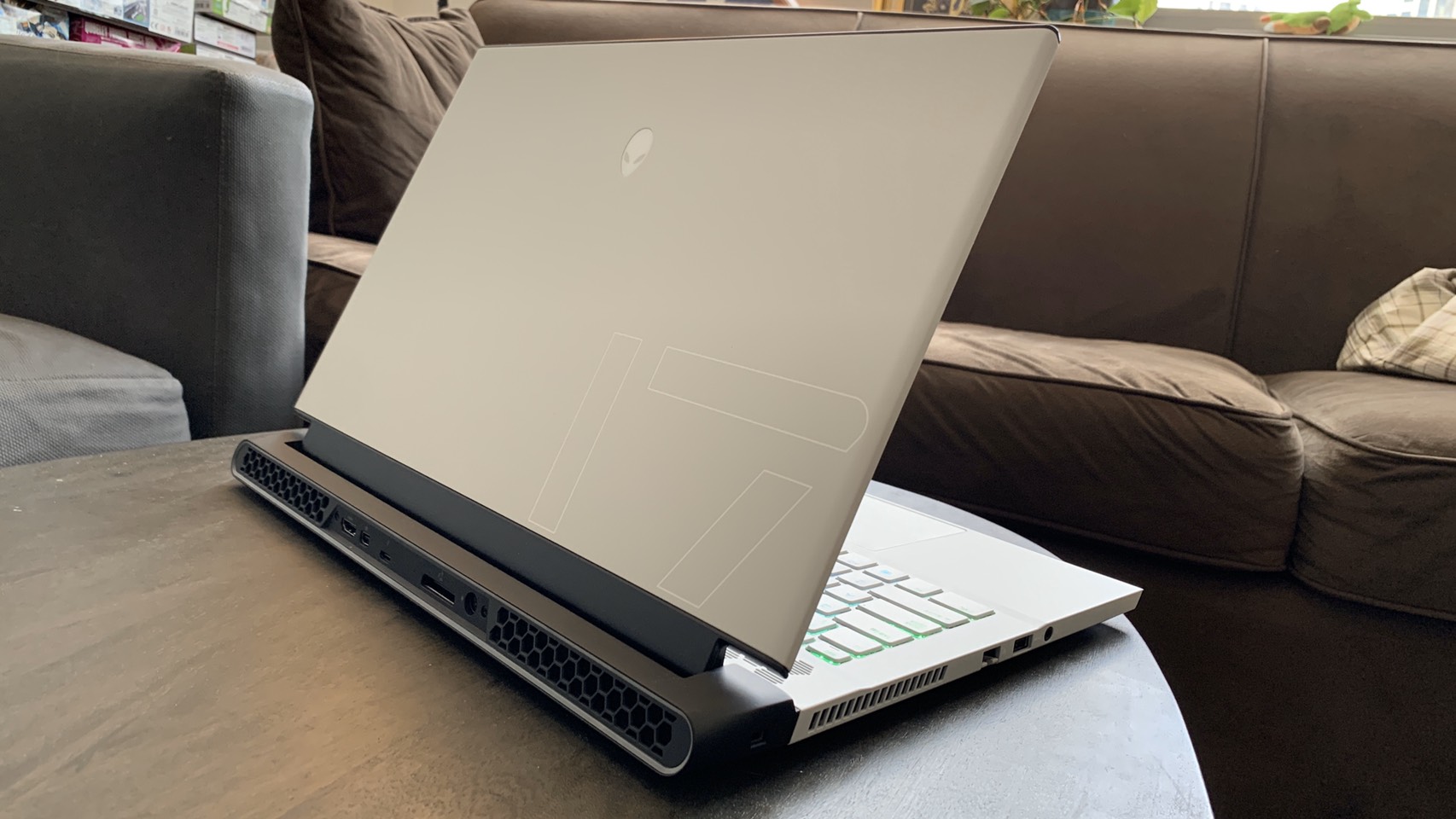

If you love RGB, prominent branding and hexagons, the Alienware m17 R3 has the look for you. Out of the box, this laptop is pure gamer premium. Encased in a white shell with a stylized “17” and an Alienware logo printed on the back, the most noticeable feature from the outside is the sheer amount of room for air intake and exhaust, nearly all of which features grills in an unusual shape.
Aside from two small diagonal grills on either of the laptop’s sides, these cutouts decorate the machine’s back and underside in honeycomb patterns. Opening the laptop reveals another set of honeycombs above the keyboard, which features 4-zone RGB (or per-key RGB as an optional add-on), a minimal font and a tenkey design. A reflective bezel also surrounds the display, where “Alienware'' is printed along the bottom. True to the brand’s reputation, all of these features come together with a clever combination of curves and angles to lend the Alienware m17 R3 a feeling akin to a spaceship.
Like a spaceship, then, the Alienware m17 R3 is a large machine, coming in at 15.7 x 11.6 x 0.9 inches and 6.6 pounds. That puts it an inch longer and thicker as well as a pound heavier than competitors like the Gigabyte Aero 17 HDR XB from earlier this year (15.6 x 10.6 x 0.8 inches and 5.5 pounds) as well as several inches and pounds over this year’s more discrete MSI GS66 Stealth (14.2 x 9.7 x 0.7 inches and 4.6 pounds). Those designs, however, used Nvidia’s Max-Q graphics cards, while this larger machine can use one at full power.
Coming in a sturdy magnesium alloy shell, the Alienware m17 R3 is a well made laptop with durability to match its heft. Solid throughout, the inside of the laptop feels thick, well-protected and comfortable to rest your hands on, while the back of the display doesn’t flex inwards under pressure. It almost feels like it could survive a drop, though I wouldn’t recommend it.
Ports on the Alienware m17 R3 are abundant and varied. Starting on the laptop’s left side, you'll find an RJ-45 Ethernet connection, one USB 3.1 Gen 1 Type-A port and one 3.5mm combination headphone and microphone jack. The right side has two additional USB 3.1 Gen 1 Type-A ports as well as a microSD card reader. That alone isn’t necessarily impressive, but the m17 R3 also has several ports along its back, including an HDMI 2.0b port, a Mini-Display port, a Thunderbolt 3 port and a proprietary connector for Alienware’s external graphics amplifier boxes.
Gaming Performance on Alienware m17 R3
Our Alienware m17 R3 review configuration came decked out with a 10th generation Intel Core i9-10980HK processor, an Nvidia Geforce RTX 2080 Super and 32GB of DDR4 memory.
The Alienware m17 R3 impressed in our Far Cry: New Dawn (ultra) benchmark, where it scored an average 89 fps at 1080p and 53 fps at 4K. That’s about 15 fps over the Aero (with its RTX 2070 Super Max-Q) on both resolutions, with the competitor only hitting 76 fps at 1080p and 39 fps at 4K. The Stealth, with an RTX 2080 Super Max-Q, earned an average 86 fps at 1080p (it doesn’t have a 4K screen).
Get Tom's Hardware's best news and in-depth reviews, straight to your inbox.
The Alienware also fared well on our Shadow of the Tomb Raider (highest) benchmark, netting an average fps of 89 at 1080p, but falling under 30 fps at 4K. That’s to be expected on settings this high, though, and is still higher than both the Aero’s 61 fps at 1080p/21fps at 4K score and the Stealth’s 66 fps at 1080p score.
The Alienware m17 R3 hit its highest framerate on the Grand Theft Auto V (very high) benchmark, where it performed at an average 98 fps at 1080p and 34 fps at 4K. Once again, that’s above the Aero’s 77 fps @ 1080p and 24 fps @ 4k scores, as well as the Stealth’s 82 fps @ 1080p score.
We also put the m17 R3 through our gaming stress test, where we ran the Metro Exodus 1080p RTX preset benchmark on a loop 15 times to simulate a half hour of gaming. The game ran at an average frame rate of 62.9 fps, which the benchmark placed in the 99th percentile among its users. The average CPU clock speed was 3.8 GHz with an average temperature of 89 degrees Celsius (189.1 degrees Fahrenheit). The GPU, meanwhile, ran at an average clock speed of 1.4 Ghz and an average temperature of 73 degrees Celsius (163.4 degrees Fahrenheit).
I also played Control for about an hour on the Alienware m17 R3, testing it at both 1080p and 4K resolutions, as well as with ray tracing on and off. At 1080p, I got a smooth 60 fps experience throughout, which I was also able to replicate when I used Control’s unique ability to render characters at 4K and environments at 1080p. This dropped to around 30 fps when I played entirely in 4K, though my experience was smooth there as well. The game’s ray tracing features didn’t seem to make much of a difference, both on screen and in my fps, but I’m happy to report that even during hectic gameplay, I didn’t lose frames on any settings.
Productivity Performance on Alienware m17 R3
With such a powerful rig, meant to support an Nvidia Geforce RTX 2080 Super, the Alienware m17 R3 is also well-suited to productivity tasks.
With both Excel and the Epic Games Store open in the background, the Alienware m17 R3 was able to open 35 Chrome tabs, including 3 YouTube videos and one 1080p @ 60 fps Twitch stream, with no delay. This is to be expected of its 32GB of RAM and its 8 core, 16 thread Intel 10th Gen Core i9-10980HK processor, which runs at a base clock speed of 2.4 GHz and a max clock speed of 5.3 GHz. However, even with this casual task, the computer’s fans got quite loud, so we recommend turning your thermal mode to quiet in the Alienware Control Center for casual use.
Moving on to our Geekbench 5.0 benchmark, the Alienware m17 R3 came out on top, scoring 7,579 against the Aero’s 7,298 (Core i7-10875H) and the Stealth’s 6,328 (Core i7-10750H). That’s a narrow lead over the Aero, but well above the Stealth.
In our file transfer test, where we track how long it takes each computer to transfer 4.97GB of files, the m17 R3 took 5 seconds, or a rate of 1,018 MBps. That places it above the Aero’s 848 MBps, but below the Stealth’s 1,696 MBps.
We also put the Alienware m17 R3 through a Handbrake video transcoding test, which transcodes a video from 4K resolution (3840 x 2160) down to FHD (1920 x 1080). Alienware's laptop once again led the pack here, completing the task in 7 minutes and 16 seconds. That’s slightly faster than the Aero’s completion time of 7 minutes and 58 seconds, and considerably under the Stealth’s score of 9 minutes and 25 seconds.
Display on Alienware m17 R3
Our review configuration of the Alienware m17 R3 came with a 4K @ 60 Hz HDR400 display with a 25 ms response time, though there are also other models with a 1080p @ 144 Hz display and a 9 ms response time instead. When configuring, you'll need to decide whether refresh rate or color and sharpness matter most to you.
The 4K resolution makes for a great visual experience, assuming high refresh rates aren’t a chief priority. I didn’t notice any discernible input lag when using the laptop to play Control, meaning that the display should hold up well for at least single player games. Colors were also vivid and the screen could get uncomfortably bright if I wanted it to, with its high default brightness being the first thing I noticed about the laptop when I opened it up.
This strong display experience carried over to video playback, which I tested using the open source 4K short film Tears of Steel. Here, the movie’s abundance of 3D models were bright, easy to track and pleasing to the eye, with colors not getting lost in darkness and the action never appearing blurry.
Our testing backed up my anecdotal experience, with the 4K version of the Alienware m17 R3 capturing 117.5% of the DCI-P3 color gamut and achieving an average brightness of 591 nits. That’s over both the Aero’s 466 nits of brightness / 115.1% DCI-P3 coverage and the Stealth’s 321 nits / 79% DCI-P3 range.
Keyboard and Touchpad on Alienware m17 R3
The Alienware m17 R3’s keyboard was so comfortable that I ended up writing this whole review on it, willingly abandoning my desktop’s mechanical keyboard for the change of pace.
The chiclet design is comfortable and responsive, likely thanks to its 1.4mm key travel and anti-ghosting technology. Despite the laptop not featuring mechanical keys, I was able to regularly hit 75 words per minute on 10fastfingers.com, which matches my usual score on my Corsair mechanical keyboard.
This might also be due to the keyboard’s sturdy design, which doesn’t flex under even heavy strain, and is clicky on presses, as if I’m pushing into smooth depressions in an otherwise flush, solid wall.
The Alienware m17 R3's 4.2 x 3.2 inch glass touchpad uses Windows precision drivers and is smooth to the touch. Unfortunately, its placement slightly to the left of the laptop’s center meant my palm unintentionally brushed against it several times while I was using the laptop to play Control. This frequently threw off my aim and left me diagnosing the problem for about 10 minutes before I realized what was going on. Thankfully, you can turn the touchpad off and just use an external mouse.
Audio on Alienware m17 R3
The Alienware m17 R3 features two front facing speakers across the bottom half of its case, which seem to prioritize volume over sound quality. During my testing, I could blast We Will Rock You loud enough to fill my two-bedrooom apartment, but without a dedicated subwoofer, the m17 R3 completely dropped its opening drum solo. Its ending guitar solo was also Fisher Price levels of tinny.
Higher frequencies fared slightly better, with A-ha’s Take on Me chorus coming across clearly, though its bassline once again suffered.
Because the m17 R3 is a gaming laptop, Alienware likely expects users to wear headsets while playing on it. Still, while playing Control, I was able to track my opponents and pick up on audio queues well enough, so the built-in speakers provide a decent way to keep track of your surroundings in a game. Just don’t expect those surroundings to sound their best.
Upgradeability of Alienware m17 R3
To open the Alienware m17 R3, we used a Phillips Head #1 screwdriver to remove the eight screws along the bottom, after which the bottom panel came off without the use of a spudger. Taking off the panel revealed the battery and the two M.2 SSDs, both of which are easily replaceable. Unfortunately, the RAM is soldered in and the Wi-Fi card is inaccessible.
Battery Life of Alienware m17 R3
As you might expect from a 17-inch gaming laptop with high-end parts, the Alienware m17 R3 has poor battery life. Using the Tom's Hardware Battery Test, which simulates standard computing workloads by continuously browsing the web, streaming video and running OpenGL tests at 150 nits, the m17 R3 lasted just 2 hours and 29 minutes.
While that’s often fairly typical for gaming laptops, that’s still well under the Gigabyte Aero 17 HDR’s 6-hour and 28-minute battery life and the MSI GS66 Stealth’s 6-hour and 36-minute endurance.
If you want the m17 to last you a day, you’ll need to bring your power brick with you. And considering the power brick weighs 2.8 pounds and comes in at 7.8 x 3.6 x 1.5 inches, that’s a big ask.
Heat on Alienware m17 R3
The Alienware m17 R3's main touchpoints stayed reasonably cool during testing, but as is commonplace with gaming laptops, the side vent belched hot air.
After running YouTube for 15 minutes, the touchpad was quite cool, registering 26.2 degrees Celsius (79.2 degrees Fahrenheit). That’s about 13 degrees cooler than the center of the keyboard, which was 33.3 degrees Celsius (91.9 degrees Fahrenheit) just between the G&H keys. The hottest part of the laptop was the underside, which ran slightly warmer than the center of the keyboard at 33.7 degrees Celsius (92.8 degrees Fahrenheit). On a machine as high-performance as this, we tend to consider temperatures under 95 degrees Fahrenheit as really good and those under 100 as bearable.
However, even during casual use, the fans on the Alienware m17 R3 constantly output hot air. This is good for the laptop’s internal temperature, but it does make placing your hands either behind it or to its sides uncomfortable. That’s unfortunate for your mouse hand, and applies to the bottom too, which means you’ll want to place the m17 R3 on a desk rather than your lap.
Webcam on Alienware m17 R3
The Alienware m17 R3 comes equipped with a 720p webcam that’s well-hidden in the top bezel. It’s got an internal light for dark environments, and its frame rate was comparable to my standard 1080p Logitech webcam when calling into a morning meeting.
Its colors are also bright and vivid, particular for lighter colors like pink and yellow, which when combined with its high frame rate had me mistaking it for a 1080p camera on first blush. Unfortunately, after looking at some photos I took with it, I noticed heavy pixelation on detailed surfaces, revealing its low-res nature.
The Alienware m17 R3’s 4K configurations also come with Tobii eye tracking, which I tended not to notice aside from my screen reliably dimming and relighting based on whether I was looking at it or away from it. Some games do feature functionality for it, but not many.
Software and Warranty on Alienware m17 R3
The Alienware m17 R3 comes mostly free of bloat. You’ll still encounter the standard Windows pre-installs like Candy Crush and Farm Heroes, but there are no Norton trials or proprietary media apps here.
What you will find are the Alienware Command Center and Alienware Mobile Connect, two genuinely useful programs that either add new features or centralize existing ones. The Alienware Command Center acts as a hub for the m17 R3’s gaming features, allowing users to control the keyboard’s RGB lighting, set the laptop’s power consumption mode, enable and adjust overclocking, access their game libraries, set music for different tasks and perform other quality-of-life functions. Alienware Mobile Connect, meanwhile, lets you connect your phone to your laptop to either text with its keyboard or mirror apps on its screen.
The Alienware m17 R3 comes with Dell’s standard one-year limited warranty.
Configurations of Alienware m17 R3
We tested the Alienware m17 R3 with fully decked-out specs, meaning it came equipped with a 10th Gen Intel Core i9-10980HK CPU, an Nvidia GeForce RTX 2080 Super, 32GB of RAM, two 1TB PCIe M.2 SSDs connected over RAID 0, a 4K 60Hz display and a 86 WHr battery. That’s a powerful machine, with a powerful $3,529.99 price tag to match.
If you don’t need that much power, the base model of the Alienware m17 R3 comes in at a more affordable $1,549.99, and swaps the CPU for a 10th Gen Intel Core i7-10750H and the GPU for an AMD Radeon RX 5500M. It also lowers the RAM to 16GB and the storage to 256GB, and decreases the screen resolution to 1920 x 1080 but with a 144 Hz refresh rate
There are two Nvidia-based models with 144 Hz displays -- one for $2,249.99 and one for $2,449.99. The cheaper option here has all the same specs as the base model, except for 16GB of additional RAM, an extra 256GB SSD, and an Nvidia Geforce RTX 2070 Super in place of an AMD GPU. The more expensive option keeps all of those specs, but swaps out the dual 256GB SSDs for dual 512GB SSDs.
There’s also a slightly-cheaper 4K model from our version, which has all the same specs as our review unit, except for a slightly-less-powerful RTX 2070 Super GPU and only 1TB of storage split across two 512GB SSDs. It costs $3,099.99.
Bottom Line
When configured with similar specs to our review unit, the Alienware m17 R3 comes equipped with Intel’s most powerful mobile CPU and pairs it with an equally strong graphics processor. Its 4K screen also excels at displaying that power, though a 60 Hz refresh rate and 25ms response time means this laptop lends itself more to single player adventures than competitive greatness.
A downside to having this much high-end power is that the m17 R3 blows out some hot air and its fans can get annoyingly loud, though changing power presets helps. If you want something quieter, the Gigabyte Aero 17 HDR XB offers slightly less impressive specs in exchange for a more discrete presence. Meanwhile, the MSI GS66 Stealth comes with a 300 Hz screen that’s more suited for competitive play.
However, if you want top-of-the-line performance in a very attractive chassis with an eye-popping display, the Alienware m17 R3 is hard to beat.
Michelle Ehrhardt is an editor at Tom's Hardware. She's been following tech since her family got a Gateway running Windows 95, and is now on her third custom-built system. Her work has been published in publications like Paste, The Atlantic, and Kill Screen, just to name a few. She also holds a master's degree in game design from NYU.
-
jeremyj_83 Would have been interesting to see productivity tests with a 4900HS in the graph. I did look at the Zyphyrus G14 review to see if there were any common tests between it and the m17. There was one which is Handbrake and the G14 was able to finish the test 17 seconds or 4% faster than the m17. Now the question will be what will it take for companies like Dell to use the AMD CPU in their halo gaming or workstation laptops.Reply -
jeremyj_83 Reply
Who has more stable drivers?Rockandrolla said:More stable drivers all around. As a system builder they are still a mess. -
cgeorgescu So you compare a huge and heavy laptop with two thin and light ones... Why? Why not compare it with a similarly heavy and big laptop that comes with GTX2080?Reply
Ah, because it wouldn't get the slightly better framerates and it won't fare that good, right? And you have an agenda.
You see what people understand form this review? They get that a very heavy, big and expensive Dell machine is only marginally more powerful than two slim and elegant laptops that are way cheaper. -
Seregosa Replycgeorgescu said:So you compare a huge and heavy laptop with two thin and light ones... Why? Why not compare it with a similarly heavy and big laptop that comes with GTX2080?
Ah, because it wouldn't get the slightly better framerates and it won't fare that good, right? And you have an agenda.
You see what people understand form this review? They get that a very heavy, big and expensive Dell machine is only marginally more powerful than two slim and elegant laptops that are way cheaper.
Are you stuck a few years back? The legend design made the alienware laptops way lighter and thinner than before. While the MSI is indeed lighter and smaller, it's a 15" laptop with dimensions similar to the m15r3, the m17r3 and the aero 17 hdr on the other hand are pretty much identical in dimensions. Both weigh around 2.5kg with similar size. So I really don't know what you're on about. You don't get smaller and lighter gaming laptops at 17" than that unless you want to sacrifice a lot of performance.
Well, I bought the m17r3, just waiting on it to be delivered. Why? Because it's cheaper than pretty much any other laptop with similar specs while having warranty and customer service way superior to most as long as you get the premium alternatives and it's still one of the acknowledged best brands. Of course, if I had a lot more money to spend and didn't care about warranty, I'd probably go with a razer or something instead, but I can't justify the extra price and subpar warranty(at least subpar in my country). It also has 32gb ram which most gaming laptops don't.
Got it with a 12% coupon off and on top to that I managed to get myself a 7% total price refund once it's sent because dell made a site blunder which forced me to re-order my laptop again. Shows they care about their customers. So, close to 20% off a brand new, released-last-month laptop. Also got 15% off on premium plus for 3 years(which is exactly what I needed as I'll sell it after that for 50% of the purchase price to fund a new laptop, can rest assured that it will work until then or they'll fix it for free by sending technicians to my house).
I do agree that the old alienware laptops were very bulky, but so were most laptops. I remember one I bought 6 years ago, quite bulky and was a pain to carry around, but with the slimmed design of this one it won't be a problem even though it's a 17". Also, for the battery issue, it's just a matter of knowing what to do. First of all, turn off that damn crap called tobii eye tracking. It's utter <Mod Edit>. Had it on a m15r2 I tried out last year, ended up completely nuking the drivers until it couldn't even be detected anymore. It slows down the laptop and sends the CPU running all the time so that it never enters an idle state, draining a lot of extra power for nothing. Wish I could order one without it, but at least the problem's solved if you delete all the drivers and uninstalls everything related to it so that it can't auto-install it again. Trust me, it's a power sink. Other than that, the 4k screen is very bright, can easily turn down the brightness a lot. And as with all thin gaming laptops, it's in your best interest to undervolt it for consistent performance and to lower temps along with power consumption. Then you can fiddle with power setting to lower cpu base frequency and also gotta make sure that it uses the CPU GPU when idle so that it doesn't just turn on the gaming GPU randomly when you don't need it. Bet you can raise the battery time to compete with the other laptops then. At the very least 4-6 hours instead of 2-3 hours should be easily doable for normal use. Can't hope for much more when it comes to a laptop specced for performance. Honestly glad if I can at least get 3-4 hours, that's enough, usually never away from outlets for longer than that anyway. -
comprodigy Dells really been buying these reviews lately huh? Both this and the G5 SE both didn't go to any reputable reviewer that is actually going to get into things that matter (clock speeds, temps, noise).Reply
Alienware is infamous for bad cooling on their CPUs, and sometimes GPUs, but that wasn't tested here. Why? Were you not allowed? Why was it compared against nothing but Max-Q laptops? Why no detailed analysis of actual performance except for needless things like drive speed. Alienware got me twice with bad laptops, not doing it again, and these reviews only lead me to believe they are continuing to hide their crap design behind bought reviews. -
Seregosa Just received my m17r3 a few days ago. Out of the box, it has an unremarkable battery life of 2-3 hours while using. But it's truly not fair to say that it has a bad battey life if you don't tweak things to suit your needs. There is no real difference between this and other gaming laptops in terms of battery, it's just a matter of settings or similar stuff they come with. First of all, turning off tobii eye tracking and completely uninstalling it as it's useless for anything but waking the laptop up, which is worthless, is a good idea. That thing takes power all the time. The second thing to do is to go into advanced power settings and change network adapter settings on battery to "maximum power saving"(unless you need it to be better all the time, the have noticed no real issues with maximum power saving on, so just try it) and then change the processor power management. "Minimum processor state" should be at 5% for both, while I found "maximum processor state" to be easily good enough at 80% for battery and 95% plugged in. The thing is that this laptop is overclocked ALL THE TIME, which is the reason for the poor battery life. Look in the task manager and you'll see the processor always going to 3.5-4+ ghz even when not doing anything requiring it. This is the source of the problem. Changing "maximum processor state" will force it back to original clock speeds. Even just changing it to 99% means it will only be at around 2.3-2.4 ghz, 95% is about 2.2-2.3ghz and 80% means it'll be around 1-2ghz which is more than enough for casual use when you're not gaming or similar stuff. Can also create a shortcut to the advanced power options, or if you want to, just open alienware command center whenever you feel like gaming and change it to "max performance" and it will automatically change all these settings to the best possible for performance and then when you go back to balanced it will change settings to what you previously used.Reply
I now get over 7 hours of battery life from casual browsing and at least 5-6 hours watching videos. That's quite good for a gaming laptop. Can probably make it even more energy efficient, like turning off wifi and bluetooth entirely or further turning down processor max state if you're in a true bind and need extra power by all means necessary.
Oh, and these settings that I have now give me a nice and very cool laptop. The fans are literally never on unless I do something requiring a lot of system resources. Even with no fans on, it stays at around 38c for gpu and 42c for the cpu on idle while browsing or watching movies. Even when in hotter locations(25C or so), it still stays around 40c for the gpu and 45 for cpu. Also, this is with the 4k screen so the 1080p screen users can probably expect it to get a bit more battery out of it, though I do run my screen at around 50% brightness for casual use because that is easily bright enough with the insanely bright 4k display. By the way, a tip is to go into "intel graphics command center", then "system" followed by "power" and turn off "display power savings". It does hardly anything at all for power savings but it has the nasty habit of brightening or dimming your screen depending on background, something I find very noticeable and annoying, took me a while to find that setting, it was truly annoying while on battery power that it brightened white screens and dimmed dark screens...
I feel like the main issue everyone has with the m17r3 is the battery life and how warm it is with "noisy" fans. These tweaks solves all of that completely unless you're cranking everything up for a gaming session, in which case you should have some headphones on anyway and it doesn't matter. -
Loaspra Reply
It is not a fair comparissoon. the other 2 laptops have Max-Q graphics, and the m17 the Max-P variant.Seregosa said:Are you stuck a few years back? The legend design made the alienware laptops way lighter and thinner than before. While the MSI is indeed lighter and smaller, it's a 15" laptop with dimensions similar to the m15r3, the m17r3 and the aero 17 hdr on the other hand are pretty much identical in dimensions. Both weigh around 2.5kg with similar size. So I really don't know what you're on about. You don't get smaller and lighter gaming laptops at 17" than that unless you want to sacrifice a lot of performance.
Well, I bought the m17r3, just waiting on it to be delivered. Why? Because it's cheaper than pretty much any other laptop with similar specs while having warranty and customer service way superior to most as long as you get the premium alternatives and it's still one of the acknowledged best brands. Of course, if I had a lot more money to spend and didn't care about warranty, I'd probably go with a razer or something instead, but I can't justify the extra price and subpar warranty(at least subpar in my country). It also has 32gb ram which most gaming laptops don't.
Got it with a 12% coupon off and on top to that I managed to get myself a 7% total price refund once it's sent because dell made a site blunder which forced me to re-order my laptop again. Shows they care about their customers. So, close to 20% off a brand new, released-last-month laptop. Also got 15% off on premium plus for 3 years(which is exactly what I needed as I'll sell it after that for 50% of the purchase price to fund a new laptop, can rest assured that it will work until then or they'll fix it for free by sending technicians to my house).
I do agree that the old alienware laptops were very bulky, but so were most laptops. I remember one I bought 6 years ago, quite bulky and was a pain to carry around, but with the slimmed design of this one it won't be a problem even though it's a 17". Also, for the battery issue, it's just a matter of knowing what to do. First of all, turn off that damn crap called tobii eye tracking. It's utter <Mod Edit>. Had it on a m15r2 I tried out last year, ended up completely nuking the drivers until it couldn't even be detected anymore. It slows down the laptop and sends the CPU running all the time so that it never enters an idle state, draining a lot of extra power for nothing. Wish I could order one without it, but at least the problem's solved if you delete all the drivers and uninstalls everything related to it so that it can't auto-install it again. Trust me, it's a power sink. Other than that, the 4k screen is very bright, can easily turn down the brightness a lot. And as with all thin gaming laptops, it's in your best interest to undervolt it for consistent performance and to lower temps along with power consumption. Then you can fiddle with power setting to lower cpu base frequency and also gotta make sure that it uses the CPU GPU when idle so that it doesn't just turn on the gaming GPU randomly when you don't need it. Bet you can raise the battery time to compete with the other laptops then. At the very least 4-6 hours instead of 2-3 hours should be easily doable for normal use. Can't hope for much more when it comes to a laptop specced for performance. Honestly glad if I can at least get 3-4 hours, that's enough, usually never away from outlets for longer than that anyway.
Anyway I love the design of the m17, I would buy one but the MSI ge75 raider is cheaper and more powerfull. It can achieve 71 fps in SOTTR with a 2070 super (115w). So, I don't think is reasonable to buy the m17 instead of the ge75, (if battery life isn't a problem). Oh, and the ge75 offers an 8 core processor + 2070 super Max-P graphics for USD 2,299. CHill -
Michaelkeating I really like the way this machine looks and performs. My only question is whether as a 50 year old guy who plays things like WoW, Civ, and Surviving Mars but would use it to watch movies with the wife if the 4k screen is worth getting over the 300mhz screen. It seems like the 25ms response time would not matter to me in gaming but I'm not an expert.Reply
